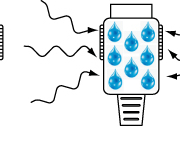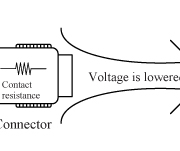A blown power fuse (Part 1)
We received an inquiry from a customer about a fuse that blew after they switched from an old to a new weighing indicator. Apparently, the old one was over 20 years old. The power circuit of an indictor that old is likely to be a series type rather than the currently popular switched-mode type.
When you choose a power fuse, you first must consider the power consumption of the device being used. At minimum, you need a fuse for a current capacity that can supply the power consumed. So, how much of a margin is needed for fuses?
Let me ask a tricky question. Imagine you have a 100 V, 60 W incandescent light bulb. When you light the bulb, how much current flows? The calculation would be: 60 W ÷ 100 V = 0.6 A. So, is it OK to use a fuse with a 0.6 A rating? The answer is “No”. Let’s try and measure the resistance value of this incandescent light bulb. A 60 W light bulb that I have on hand has a resistance value of a mere 14 Ω. If 100 V is applied, the current flowing is 7 A, right? If you actually apply 100 V, a large current flows at first but it gradually drops and eventually reaches 0.6 A. Since the filament temperature is low when the power is first switched on, the resistance value also is low, but as the temperature rises, so does the resistance value. Therefore, if the characteristics of the bulb and fuse are mismatched, the fuse blows as soon as the power is switched on. This large current when the power is switched on is called inrush current.
Let’s bring the discussion back to weighing gauges. Because they are low in noise and simple, series-type power sources (power circuits using large power transformers) were used for the power circuits of electrical devices like weighing gauges until the 1980s. These power circuits were inefficient but the inrush current was not so large. However, currently popular switched-mode power supplies have a large inrush current when the power is switched on but this current tends to flow for only a short time. Therefore, changing weighing indicator types, even for one with similar power consumption, makes it likely that the fuse will blow.
So, what can we do about this problem? You must switch to a slow-blow fuse. There are three main types of fuses.
– Fast blow
– Normal blow
– Slow blow
Slow-blow fuses strongly resist the inrush current when the power is switched on and blow like a normal fuse with further overcurrent. These fuses can be identified by the letter “T” before the rated current marking. For example, a 1 A slow-blow fuse would be marked “T1A”.
For reference, the following A&D weighing gauges use switched-mode power supplies: AD-4401, AD-4402, AD-4404, AD-4408A/C, AD-4530, and AD-4532B. (as of May 2011)







